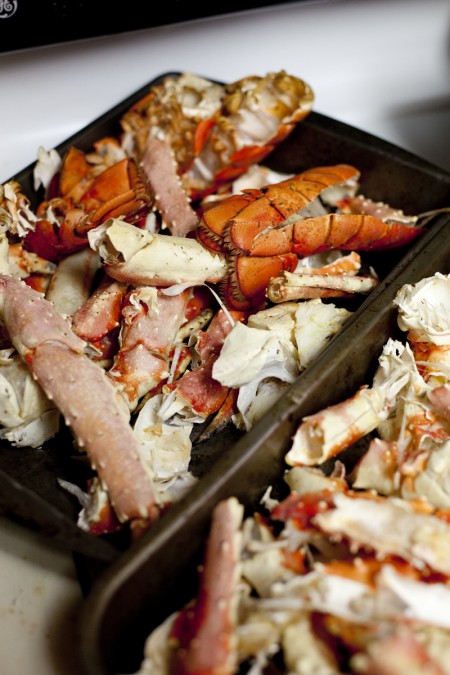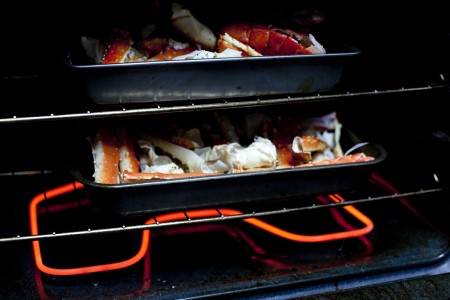
This month, Eric and I have cut our food budget in half to try and save more of the rent we get from our exchange students. I have to admit that I’ve been slacking a bit in the food budgeting due to the excuse of needing more to feed the boys. But this month, I’m back on track, meal planning and everything. One of my favorite tricks for saving money on food is making my own homemade stock. So today, I’m super excited to share my method of using seafood shells to make a rich and flavorful seafood stock recipe.
A lot of seafood stock recipes I’ve seen use fresh shellfish, but that can get expensive. I like to stretch my seafood and think that I’d cry if I used up fresh shrimp or crab in a stock and didn’t get to eat them! I first learned how to do this from some friends I used to go crabbing with in Hawaii. They actually screamed when I threw my crab shells in the trash after dinner! Then they laughed, fished them out (fished, haha, no pun intended) and after rinsing them off taught me how to make stock from the shells. Because they were Chinese, they used Shaoxing wine in the stock, so that’s what I use although sherry or white wine are more common.

It might take a while to save up enough shells for seafood stock, but it’s worth it, trust me! You can use shrimp shells, crab shells, lobster shells, even fish bones. Once you’ve made the stock, you can use it in any recipe that calls for any kind of seafood stock. That’s right, lobster shell stock, shrimp shell stock, fish stock; whatever they ask for, you’ve got it covered right here.
There are two main steps in getting the perfect stock for a seafood soup. The first is roasting. This really enhances the flavor in the shells and makes them sweet and caramelized instead of fishy. The second step is boiling, which pulls all that amazing flavor out and into the liquid.

You may notice in the photos that I have two pans full of shells. That’s because I made a double batch! I save up my shells in gallon ziploc bags in the freezer. One bag packed full is about the 5 cups you need for this recipe. I had two bags so made two pots of stock.
Now, I’m sure you’re wondering where to find recipes using seafood stock. Well, of course I have one to share with you soon (a tasty seafood risotto), but in the meantime, there are lots of bloggers out there with recipes to try. You could use this stock in Jen’s Seafood Gumbo, Matt’s Seafood Paella, or Elise’s Cioppino. I haven’t had a chance to try the recipes yet, but I trust these bloggers and have all three recipes in my meal plan for the month!

Homemade Seafood Stock

Ingredients
- about 5 cups (or about 1 1/2 lbs) seafood shells (shrimp, lobster, crab, or fish skeletons)
- 1 yellow onion, unpeeled and quartered
- 2 carrots, unpeeled and cut into chunks
- 1garlic clove, unpeeled
- 1/2 cup Shaoxing Wine (or dry sherry, dry white wine)
- 1 TBS tomato paste
- 2 sprigs of rosemary
- 1 handful of parsley
- 1 bay leaf
- 10 peppercorns
Instructions
- Heat oven to 450 degrees. Place shells in a baking pan and roast for 5-8 minutes, until they begin to turn golden.
- Place shells in a large stockpot, cover with water no more than half an inch above the level of the shells. Add onion, carrots and garlic.
- Heat on high until small bubbles rise to the surface. Reduce heat to medium and cook for one hour. From time to time remove any scum (gray bubbly foam that stays on the surface) by scooping it off with a spoon.
- After one hour, add wine, tomato paste, rosemary, parsley, bay leaf and peppercorns. Cook for another 30 minutes.
- Strain the stock through a fine mesh strainer, discarding the solids. Refrigerate for up to two days, or pour into plastic containers with at least one inch of head room and freeze up to six months.
Notes
Approximate cost/serving: This cost really depends on what seafood shells you use and what price you got them at. For instance, shrimp shells or fish bones will be much cheaper than lobster shells. To calculate the cost, I looked at how much my seafood cost and considered using the shells in stock as 1 serving of the seafood. For example, let’s look at one lobster tail. I stretched one lobster tail to feed four people in lobster macaroni and cheese, so that lobster tail made 5 servings. I got it on sale for $8 so it was $1.60 toward the cost of my stock. Shrimp shells are much cheaper. Twenty shrimp shells were only $1! One batch of seafood stock cost me about $6, at twelve cups of stock that’s still just 50 cents a cup.
Vegetarian/Gluten Free: If you eat seafood there is no other meat and it’s totally gluten free.
Nutrition Information:
Yield:
8Serving Size:
1Amount Per Serving: Calories: 138Total Fat: 1gSaturated Fat: 0gTrans Fat: 0gUnsaturated Fat: 0gCholesterol: 0mgSodium: 14mgCarbohydrates: 26gFiber: 3gSugar: 2gProtein: 5g
Nutrition information is an estimate only.

I make veggie broth out of vegetable scraps every month or so, and this looks just as easy. I could have used this recipe a couple of weeks ago!! We had crab legs for Christmas dinner, and I’m sure we ended up with a gallon ziploc of shells at the end of the night. Bookmarking for future reference!
Thank you a lot. I never knew about intensifying the flavor of the shells by roasting them, great idea. I can’t wait to try this.
Hello, can I use the outer shell of the body of the crab?
Yes absolutely Raven! A crab shell is great for seafood stock.
Great, thanks! I’ll let you know how it turns out.
I am making this now. My house smells great. I plan on canning this for future use. My husband and I were saving shells all year.
I’m so glad Rebecca, thanks for letting us know!
Can I use the heads of the prawns and lobster as well as the shells?
Yes you can! I don’t normally get whole ones so I didn’t include that, but they will be great for stock.
Absolutely awesome! I didn’t find the recipe though till I had already put the shells and all in the pot to boil, missed the roasting part but still was delicious! Next time for sure adding in the roasting, never would of thought to do that, great touch and idea to make it perfecto! I don’t make it that often but will start doing so with this recipe in smaller batches so I will always have on hand. Thank you so very much for sharing.
Hi, do you know how long could I safely keep crab shells in the freezer? I think I have frozen crab shells that have been in the freezer for about 5-6 months. Thank you.
Up to a year should still be good to use.
I’ve been saving shells from shellfish for years, even take home (other people’s and my own!) lobster shells from restaurants. A few years ago I roasted the shells like you show here, and my stock got really bitter. I suppose I left the shells in the oven too long, but they were still nice and pink when I took them out. Or maybe I simmered the stock too long. Any thoughts? I’d like to try again as I have some king crab shells left over from NYE that I can’t bear to throw away!
Interesting Melanie, I’ve never had that happen! It could be they were roasted too long, especially if it was something that had already been well cooked. For instance when I grill lobsters, I save those shells in a separate bag because they don’t need to be roasted again. You could also try making it without roasting the shells. I can’t bear to throw them away either!
5 stars !Bless you ! Finally I can end the war of the boiled stock pieces. Yes, i roast All My stock meats and vegies prior to putting them on the stove. Brushing the shells , meats or vegetables with a bit of olive oil and tomato paste mixture before putting them in the oven adds a wonderful color and depth to the stock as well (tomato paste for dark stock and olive oil alone for clear. )
Ooh that’s a great idea to use tomato paste for a dark stock. Thanks for the tip Kelly!
Thank you so much for posting these clear instructions. I am in the middle of the recipe as I write this and am really excited to add another homemade broth to my repertoire. My plans are to use this for a risotto recipe later this week!
Taught my g-daughter this recipe to teach her how to read a recipe and cook it. Came out delicious.